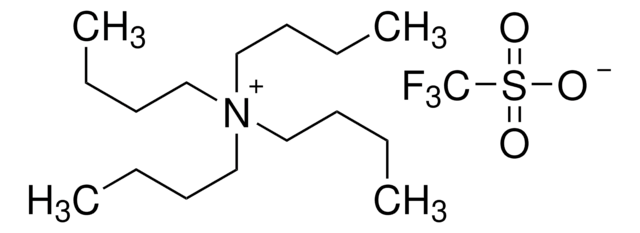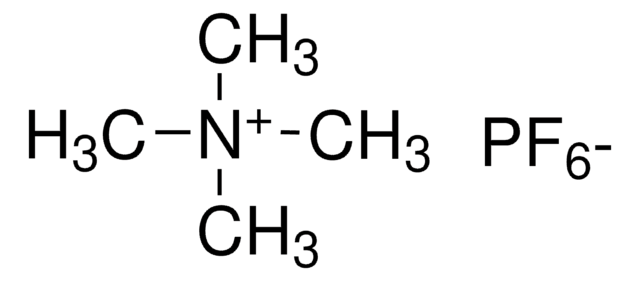217964
Tetrabutylammonium tetrafluoroborate
99%
Synonym(s):
Ammonium tetra-n-butyl tetrafluoroborate
About This Item
Recommended Products
Quality Level
Assay
99%
form
powder
mp
155-161 °C (lit.)
solubility
methanol: soluble 10%, clear, colorless
SMILES string
F[B-](F)(F)F.CCCC[N+](CCCC)(CCCC)CCCC
InChI
1S/C16H36N.BF4/c1-5-9-13-17(14-10-6-2,15-11-7-3)16-12-8-4;2-1(3,4)5/h5-16H2,1-4H3;/q+1;-1
InChI key
NNZZSJSQYOFZAM-UHFFFAOYSA-N
Looking for similar products? Visit Product Comparison Guide
General description
Tetrabutylammonium tetrafluoroborate (TBATFB) is a phase transfer catalyst. It can be synthesized by the reaction between 30% aqueous solution of tetrafluoroboric acid and 40% aqueous solution of tetrabutylamonium hydroxide. Tetrabutylammonium tetrafluoroborate acts as an electrolyte and inhibits the self-assembly of alkylthiosulfate on gold.
Application
- As supporting electrolyte in the voltammetric determination of Δ(9)-tetrahydrocannabinol (Δ(9)-THC).
- Synthesis of biologically relevant macrolactones, Sansalvamide A.
- As supporting electrolyte in the determination of the oxidation and reduction potentials of 5,10,15,20-tetra[3-(3-trifluoromethyl)phenoxy]porphyrin by cyclic voltammetry.
- Preparation of 1:1 adduct with 1,10-phenanthroline.
- Used to prepare other tetrabutylammonium salts in aqueous solutions.
- As electrolyte additive in the synthesis of conducting poly(thiophenes).
Signal Word
Danger
Hazard Statements
Precautionary Statements
Hazard Classifications
Acute Tox. 4 Oral - Eye Dam. 1 - Skin Irrit. 2 - STOT SE 3
Target Organs
Respiratory system
Storage Class Code
11 - Combustible Solids
WGK
WGK 3
Flash Point(F)
No data available
Flash Point(C)
No data available
Personal Protective Equipment
Certificates of Analysis (COA)
Search for Certificates of Analysis (COA) by entering the products Lot/Batch Number. Lot and Batch Numbers can be found on a product’s label following the words ‘Lot’ or ‘Batch’.
Already Own This Product?
Find documentation for the products that you have recently purchased in the Document Library.
Customers Also Viewed
Our team of scientists has experience in all areas of research including Life Science, Material Science, Chemical Synthesis, Chromatography, Analytical and many others.
Contact Technical Service













